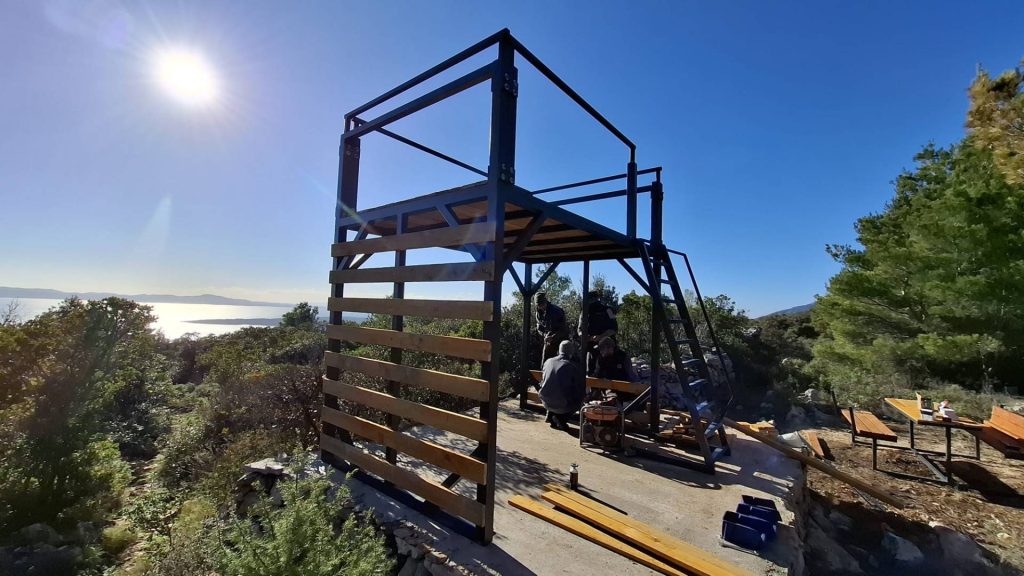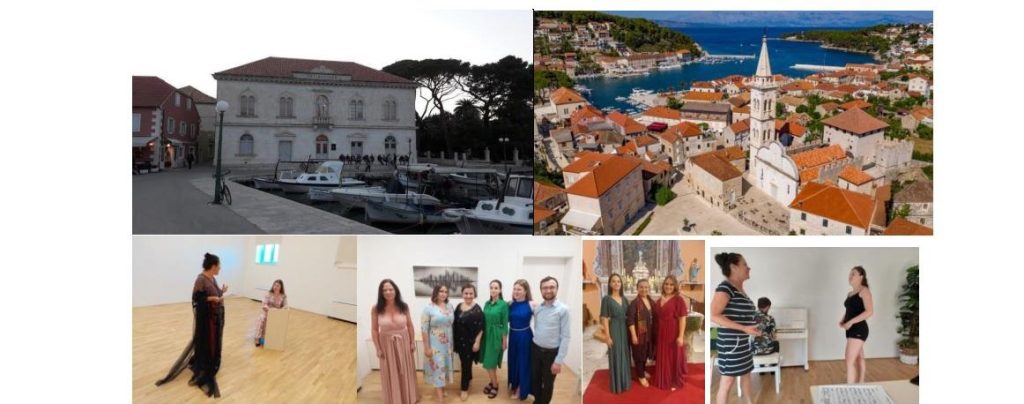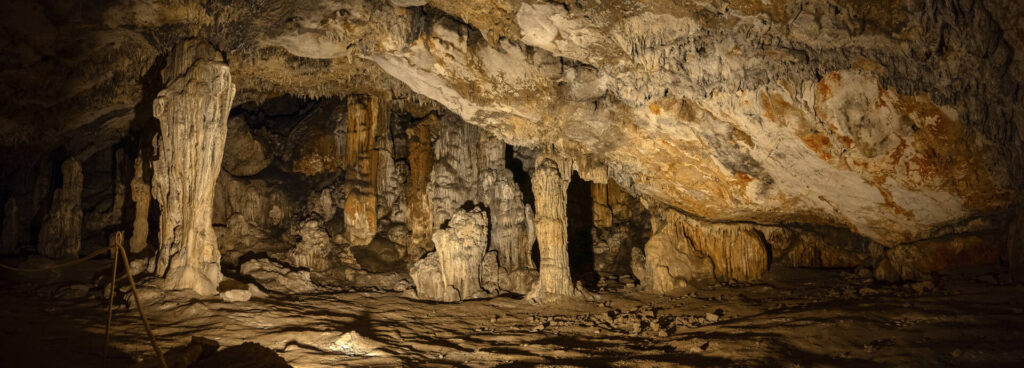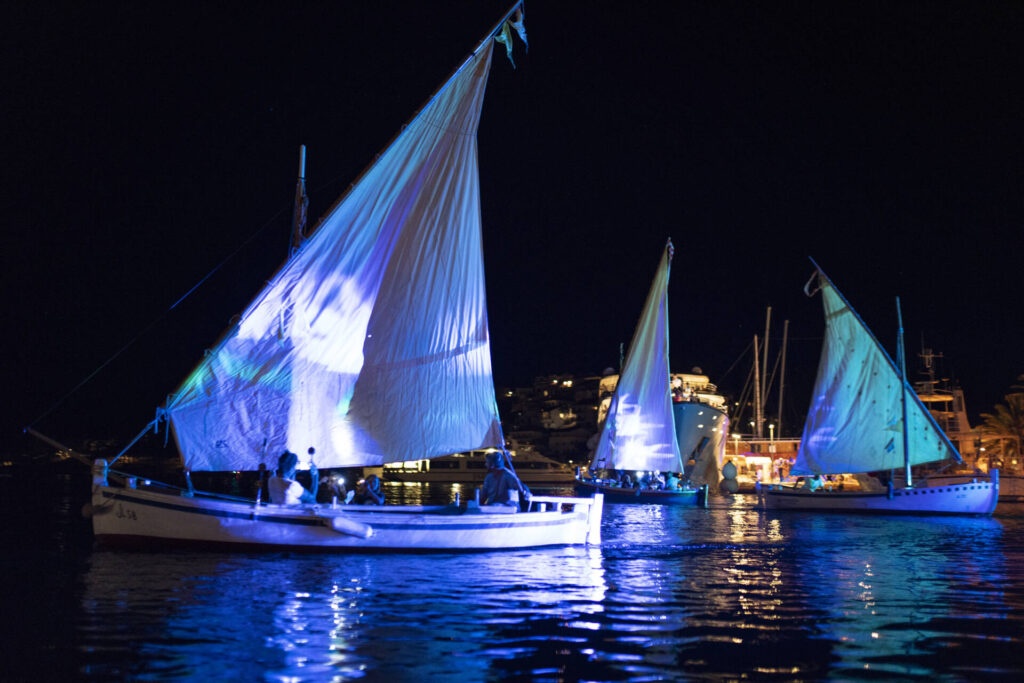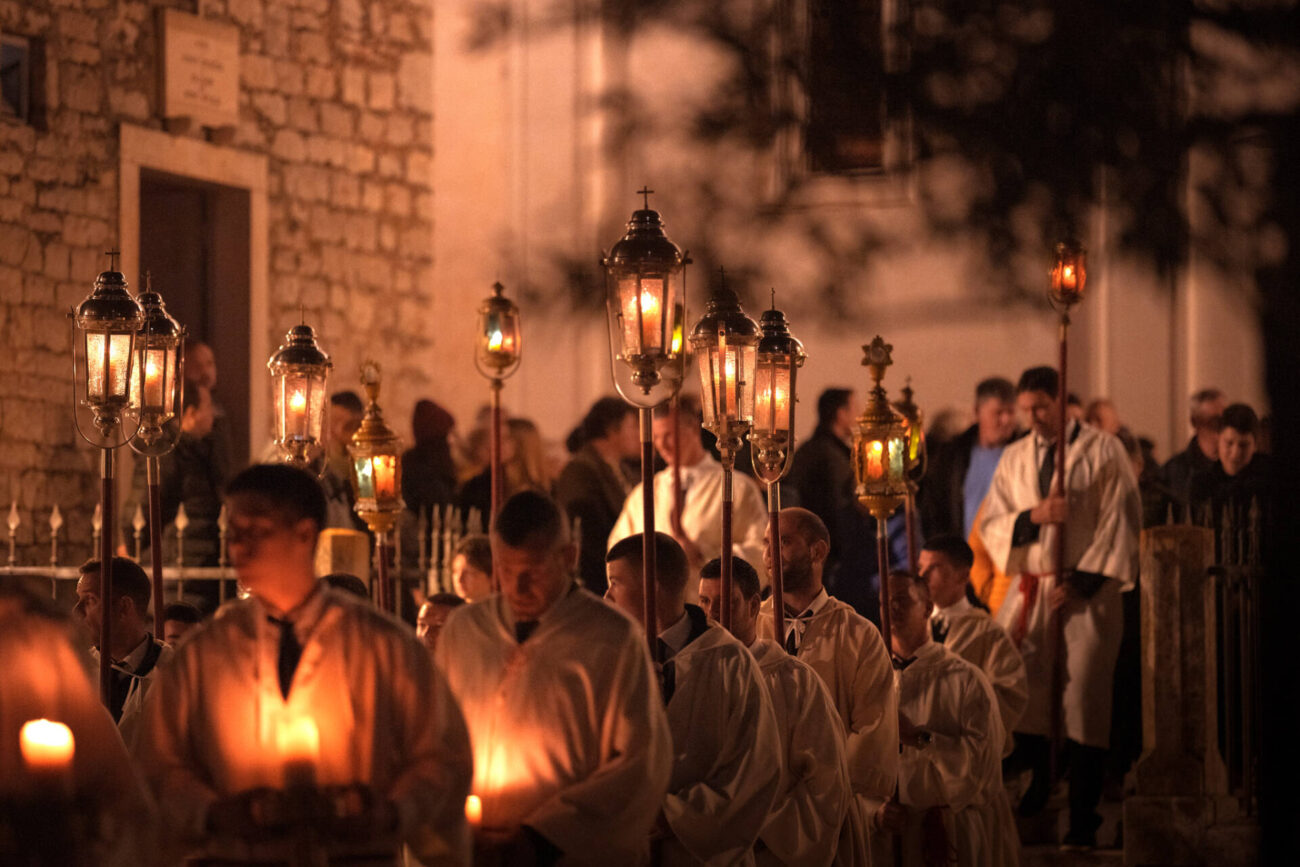
The ‘Za Križen’ Procession
About The Procession
Catholic traditions include a number of processions throughout the liturgical year. The UNESCO-listed ‘Za Križen’ (‘Following the Cross’) Procession from the Island of Hvar is an exception: although it is a deeply religious, spiritual event, it is not part of the normal Catholic calendar. It has been taking place round six settlements (Jelsa, Pitve, Vrisnik, Svirče, Vrbanj and Vrboska) in the centre of Hvar Island for some 500 years. It is organized by the lay brotherhoods (bratovštine) from each place, and normally anyone can join in.
Life on Hvar Island is full of joy and sadness. For centuries, the islanders have poured their worries, doubts, joys, sadnesses, and their personal crosses into the Procession called ‘Za Križen’, translated as ‘Following the Cross’. In this age-old tradition, the six separate Cross-Bearers, each with an entourage and a group of followers, visit representations of Jesus’ grave in a succession of churches in the central part of the island.
The Procession is called ‘Za Križen’, because it is for the people who follow their Cross, in the wake of their Cross-Bearer and his entourage.
Who carries the cross?
The Cross-Bearer is a local man from each settlement who has chosen – and been chosen – to take on the arduous task of walking through the night of Maundy Thursday carrying a veiled wooden cross weighing at least 12 kilos. Most often, the Cross is carried to fulfil a special vow, to express gratitude, or in expiation, to free the Cross-Bearer from some significant emotional troubles and pain. The Cross-Bearers generally never reveal their reason for volunteering, it remains their secret. The Cross-Bearer generally walks barefoot or in (thick) socks, but can wear shoes if he chooses. A windy night makes the 25-kilometre walk extra arduous, as the veil over the cross acts like a sail, hindering forward progress! He is normally supported by two companions, who must themselves have carried the cross in the past, in case he needs help of any kind. The cross must not touch the ground during the Procession, except when it is placed on a stand in a church.
The Cross-Bearer, his entourage and followers visit each of the six parish churches in the circuit to pay their respects to the symbolic representations of Jesus’ tomb which is arranged around the chancel. The Cross-Bearer is the leader of this people’s procession, although he is normally preceded by members of his entourage, rather than being right at the front.
A magical marathon walk
The Cross-Bearer’s entourage under normal conditions might consist of anything up to 50 men. Walking in two single lines, one group goes ahead of the Cross-Bearer and his immediate associates, while the rest follow behind. Two things make the event particularly magical: the gentle red and golden lights of the lanterns and candles progressing through the darkness of the night, and the singing. There are penitential hymns sung by the men in the Cross-Bearer’s entourage as they walk, while the women who make up the rearguard sing their prayers, such as the ‘Hail Mary’ (‘Zdravo Marijo’). In each parish church the ancient harmony of ‘Our Lady’s Lament’ (‘Gospin plač‘) is sung after the congregation’s prayers and hymns. It is a deeply evocative plaint, as a high-pitched female-sounding note emerges above the deep vibrating tones created by the singers. The chant is in three parts: two men sing the opening part, while three or four sing the response, followed by the concluding part sung by the original singers, during which the Cross-Bearer and his entourage make their way out of the church towards their next destination.
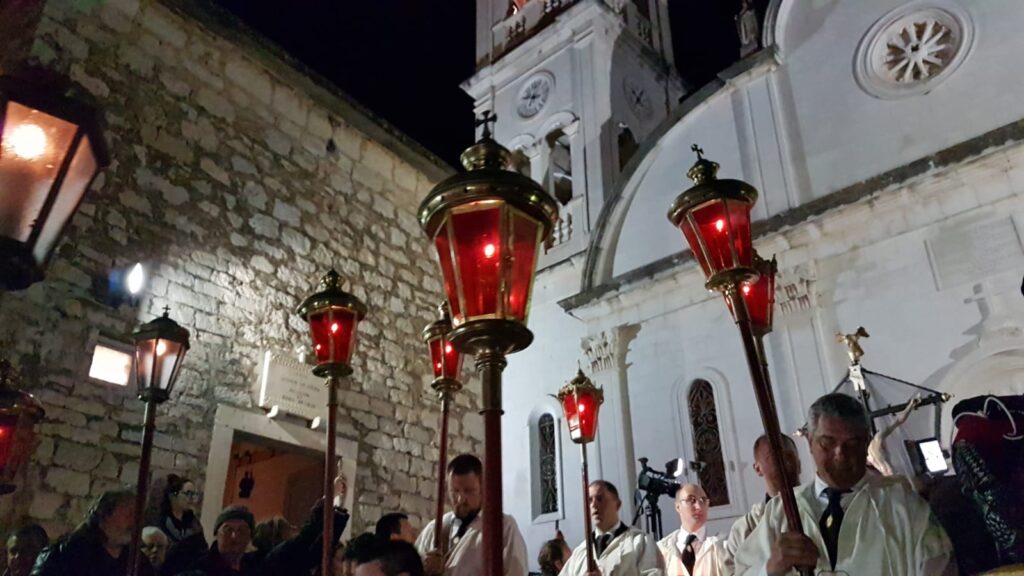
Variations in detail
Each of the six processions has its own traditions. For instance, Jelsa has a special ceremony (Primopredaja Križa) the week prior to the event, in which the cross is handed over from last year’s Cross-Bearer to the current one. There are variations in the route: for instance, the Jelsa Procession goes to Pitve along the old path through the fields, while most of the others walk along the road. The prayers are standard to all six Processions, but different hymns are sung. Besides the main churches, each of the six processions visits minor churches and chapels, according to individual preference. For instance, the Pitve Procession usually visits Jelsa’s Church of Our Lady of Health, whereas the Jelsa Procession does not.
Uniquely, the Jelsa Cross-Bearer sprints along the waterfront into Jelsa’s Pjaca, where the parish priest and community are waiting. This does not mark the end of the walk, however, as the Procession then turns off to the little Church of St. John, before heading back to the parish Church of our Lady’s Assumption. All the other Processions walk back to their home church, circle round it clockwise, as they have around each church along the way, and then go inside for the final round of prayers and singing. The parish priest may join in the Procession towards the very end. After the final hymn, all present congratulate the Cross-Bearer individually, which is usually a very emotional scene.
Each Procession ends sometime around 7 or 8am on Good Friday, after which the Cross-Bearer and his comrades retire for refreshments and a rest in preparation for the three-hour ritual which is the norm for Good Friday in the Catholic calendar.
Highly honed preparations
The ‘Za Križen’ Procession takes a lot of organizing, and is a great test of stamina, not just on the walk itself. But the long years of practice have meant that in the main everything works smoothly. In the period before Easter Week, the Cross-Bearer personally invites all those who are to form his entourage, and then gathers them together almost nightly to practise the singing, so that he can choose who will sing the Mother’s Lament, and who will be the lead singers on the walk.
Meanwhile, everyone who can is busy with other necessities, such as clearing the village paths, ensuring that the roads are clean, and baking enormous quantities of traditional dry cakes. This is Dalmatia! so eating and drinking are of course an essential part of the proceedings. The Cross-Bearer provides food and drink for his supporters during the preparatory ‘audition’ process, a meal before the Procession, and a breakfast after the finish. The breakfast on Good Friday morning, a day of fasting, is frowned upon by the clergy, but it is a long-standing tradition, not to be lightly broken.
Afterwards: Immediately after the Procession has ended, each church has to be cleared of its special decorations, and any litter cleared up, in readiness for the Good Friday service later on.
During the Easter weekend, beautiful arrangements of the little dry cakes, sometimes together with a bottle of the Cross-Bearer’s wine, are distributed to all the households which have taken part in the preparations. Finally, on Easter Monday there is a big (enormous) feast for all the men who have helped the Cross-Bearer: in Pitve that means all the men of the village, who are served by the long-suffering women – the women are rewarded at a later date for their efforts with a special celebratory meal. Obviously, all this costs a lot of money in food alone. It is customary for the Cross-Bearer to be given gifts of money or sometimes large quantities of meat ordered from the butcher’s, to defray the costs.
The Cross-Bearer has the duty of carrying the cross for all the other processions during the liturgical year. The experience of carrying the cross successfully in the ‘Za Križen’ Procession is profoundly moving and spiritually uplifting, something that all Cross-Bearers remark on afterwards.
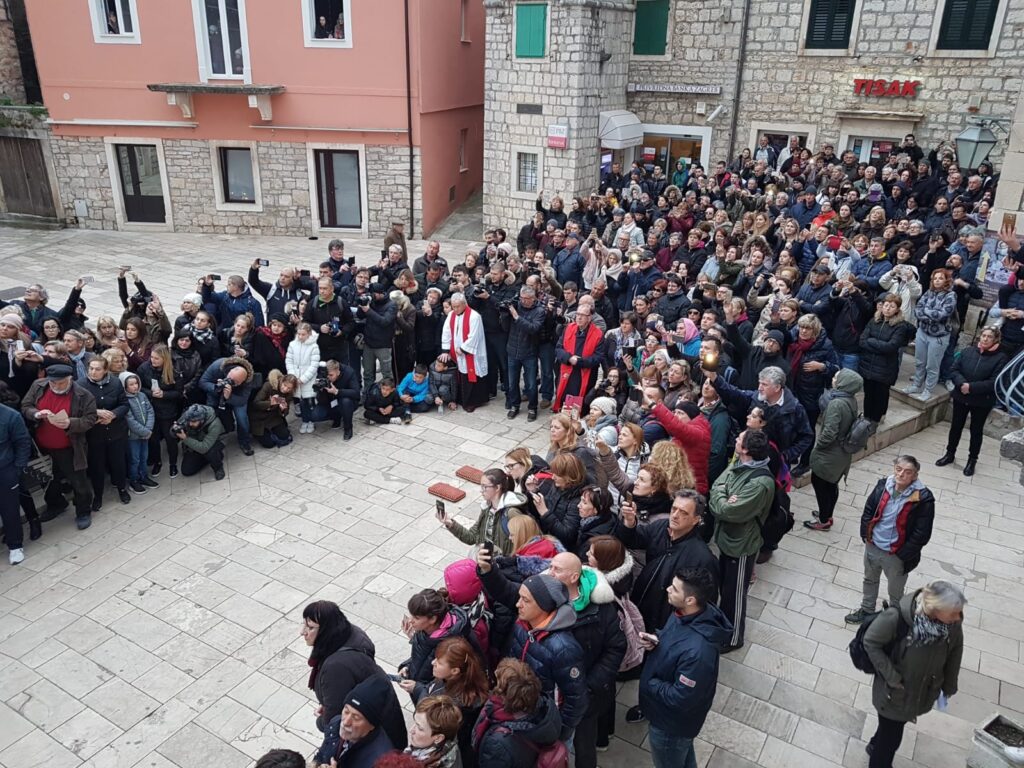
The History of the ‘Za Križen’ Procession
How did it start?: It is not known exactly when this penitential walk first started, when it was that someone in these places first came up with the idea of picking up a cross and setting off into the night. Historical evidence indicates that the procession tradition in this region is about five hundred years old, and there are various theories about how and why it started. One theory has it that it was directly inspired by the apparition of the little crucifix bleeding in Hvar Town in 1510, at the outset of the People’s Uprising, which followed three months after this event and lasted four long years. Another theory is that the tradition came about when the settlements in the central part of the island broke away from Hvar’s Cathedral Chapter. A third holds that the source and inspiration for the processions are to be found in the spiritual awareness of the Medieval Hvar islanders, and their firm reverence towards Christ’s torment, death and resurrection.
The original versions. From the first historical records describing the tradition, it is known that it did not take the same form as it does now. In the 17th century, the processions set out before dawn at about four o’clock in the morning on Good Friday, and moved between only two neighbouring settlements. Thus Jelsa’s cross was taken to Pitve and back, and Pitve’s to Jelsa; Vrisnik’s to Svirče, and so on… It is thought that today’s format of ‘Following the Cross’ round the six settlements probably began in the middle of the 19th century.
Tales from times past: Oral tradition has passed down tales of the Procession from the past. One account from the older generation describes how in 1886 there was a major storm with heavy rain on the evening of Maundy Thursday. The mayor of Jelsa had a sick daughter, and, wanting to prevent her from taking part, he issued a decree banning the Procession. Accordingly, the church was closed. However, the Procession from neighbouring Vrboska arrived at the church, and finding the doors closed, they stood in front of them and sang the lines “They won’t let me come near, they won’t let me kiss my Son” from the haunting plaint ‘Our Lady’s lament’, before moving on to Pitve. Emboldened by the courage of the Vrboska men in defying the mayor, the Jelsan Procession then set off.
According to Vrbanj chronicler Marko Pavičić, the superstition that the processions must never meet was probably the reason why a child got lost one year. In his book ‘Za Križen u riječi i slici‘ (‘Following the Cross in words and pictures’), he describes how a child fell asleep in one of the churches on the route, waking up much later when the Procession had moved on. Panic-stricken, he set off in the wrong direction and got lost. Apparently it took three days of searching to find him.
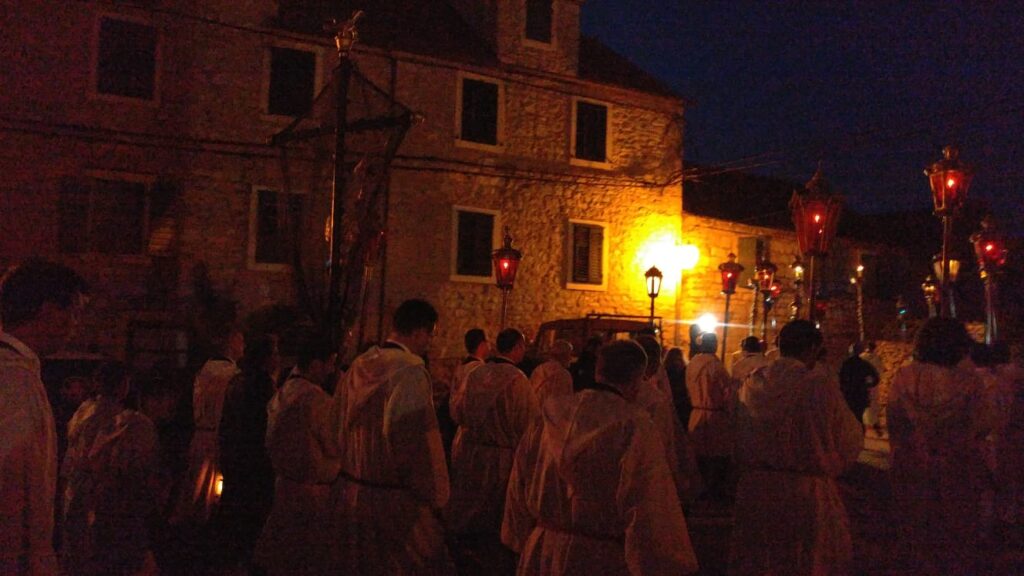
Second World War Traumas: The turbulent war years led to drama in the more recent history of the ‘Following the Cross’ Procession. On Palm Sunday, April 6th 1941, Nazi bombers attacked Belgrade, which was the start of World War II in then-Yugoslavia. People on Hvar were called up to the army, and there was doubt that the ‘Following the Cross’ Procession could take place. However, despite the dangers and uncertainties, the people set off. The churches were completely blacked out, the lanterns and candles unlit. Later in the course of the night the news arrived that Yugoslavia had capitulated, and it was safe to show the lights again.
Two years later the Procession took place in even more dramatic circumstances. In the spring of 1943, Hvar Island was under Italian occupation, and the Procession was banned. However, people pleaded with the Italian commander to allow it to go ahead, and he agreed, but under the strict condition that only ten men could accompany the Cross-Bearer. Women and children were not allowed to join in. Lights and singing were not allowed. The Commander made it clear that there would be patrols on watch during the whole night, and if more people took part than the permitted number, they would be taken prisoner and shot. Later on those who were there on that Maundy Thursday evening recalled how each of the six churches was overflowing with people for the departure of their Cross, the fear was palpable, and people were crying as if someone was being taken to the scaffold. Those who took part in the Procession went from place to place in terror, listening out for every sound, fearing the arrival of a patrol. The Vrisnik parish priest wrote of that year: “At five o’clock in the morning, the people came forward in tears towards their Cross”. The Italian commander, moved by the islanders’ determination and religious fervour, said; “If only I had known what I was forbidding … now I could kill myself”.
The Procession in Exile, 1944: People hoped that the following year would be better, and the war would finally come to an end. Sadly, in 1944 Hvar Island was full of fires, smoke and blood. People were fleeing en masse. Many found safety in the desert camp set up at El-Shatt in Egypt, which became home to some 20,000 Dalmatian refugees. On the radio, they heard the news that, for the first time in history, the ‘Za Križen’ Procession would not be taking place that year, because of the Nazi occupation. So the refugees organized six places around the barracks and tents of the camp to substitute for the six island parish churches where Jesus’ grave would normally be set up, and made six wooden crosses from planks they found in the camp. Despite a fierce desert wind blowing that night, more than 3,000 pilgrims took part, and their haunting chants and sung prayers touched the hearts of the British and American soldiers who were guardians of the camp. When the refugees finally returned home, they brought with them the wooden crosses made for that historic night.
Post-Socialism: In recent years, especially since Croatia’s emergence from the previous Yugoslav Socialist system, local males sign up sometimes years in advance for the privilege of carrying the cross. There were times during Socialism when it seemed no-one would carry the cross for some settlements, and on occasion it even seemed people would be punished for taking part, especially schoolchildren, who were often subjected to exams the next day, Good Friday, to ‘teach them a lesson’. However, the local people were never deterred from maintaining the continuity of the custom.
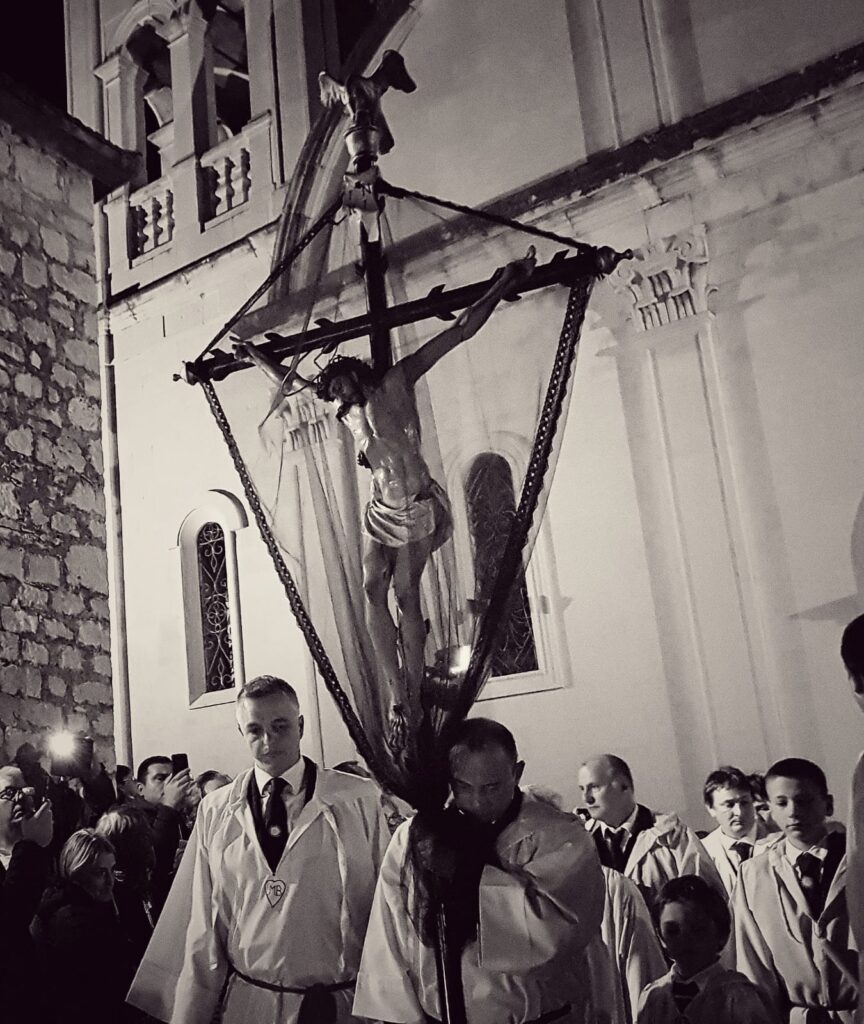
A Powerful Experience: The power of the event is amazing to the observer: how can one explain the determination of the oldest man to carry the Cross in the 20th Century, Luka Bojanić from Vrisnik, who achieved the feat in 1934, aged 83? Can one imagine the effort and suffering of Sveto Marijan from Pitve, who carried the Cross at the age of 13? Is it possible to fathom the depth of determination and will with which the people of Hvar take part in the ‘Za Križen’ Procession, regardless of wars, bad weather, epidemics or any other adversities. They were not deterred by the hurricane-force north wind of 1910, which even wrenched the lanterns from their holders; nor by the fierce storm in 1942, nor the torrential rain which fell during the whole night in 1978, when everyone was cold and wet, but no-one fell ill. Even the coronavirus pandemic in 2020 and 2021 could not put a stop to the tradition, although it took place in restricted form. The ‘Za Križen’ Procession is deeply embedded in the very heart and soul of the people of Hvar, whether near or far. Every year this special night arouses in them the deepest emotions, bringing back memories, and, most importantly, connects their footsteps to those of their forebears, strengthening their spiritual faith and their belief in a better future.
The ‘Za Križen’ Procession was inscribed on the UNESCO Representative List in 2009.
We are grateful to Jelsa Parish Priest and Vicar General Don Stanko Jerčić for making the video material available.
New guide ”Holy Week on Hvar island” – FOLLOWING THE CROSS PROCESSION




